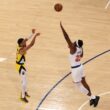With great power comes great responsibility, or so they say in Queens. For Juan Soto, it’s the mega-deal he signed for $765 million that brings the responsibility of hitting home runs and helping the Mets win baseball games.
With Soto off to a strange start this season, the question has become, what’s different? What’s different about his swing, his approach, his demeanor and his shuffle? The Mets don’t have an answer to these things because they don’t see that any of that is any different than it was with the Yankees, the San Diego Padres or the Washington Nationals.
“What’s new is the contract — that’s the biggest difference here,” manager Carlos Mendoza said Friday at Citi Field. “Everybody knows the type of money and all that went on in the offseason. And honestly, for me, I feel like the frustration is that he’s not coming through for the team, especially with runners in scoring position.”
He’s hitting just .125 with runners in scoring position, well below his .287 career average.
It’s tough to tell at times what he’s thinking since off the field, he tends to be more quiet and reserved. There are plenty of people speaking for him at the moment, ranging from fans to Michael Kay to podcast hosts who haven’t stepped foot in the clubhouse all season. He could put an end to the speculation that he’s unhappy with the Mets by speaking for himself, but the Mets have controlled his media tightly this season and that doesn’t seem to be a trend that’s going to change anytime soon.
The biggest statement he could make would be on the field.
Soto has hit into some bad luck, and he’s also taken some pitches he might not have otherwise laid off. The Mets think pitchers around the league are starting to take notice and exploit his hesitation. However, his underlying numbers are mostly hovering around his career averages, with the exception of his bat speed, which appears to be slower than it’s been in recent seasons, down about two ticks to 73.4 MPH, from 75.4 MPH last year.
But his expected numbers are still exorbitant because, as Mendoza said, he’s making hard contact.
“We want him to keep doing what he’s doing,” said hitting coach Jeremy Barnes. “I mean, he’s one of the best swingers in the league. So [the message] is, ‘Don’t get outside yourself, don’t take in all the noise, just keep doing what you’re doing and keep hitting the ball hard. Take your walks and hit the ball hard.’ That’s all we can control.”
Soto has not deviated from his routines and has not shown any outward frustration. He’s still diligent in his pregame work and treats those around him with respect. The Mets often talk about showing up as the same person every day, and Soto has been consistent with his attitude and his demeanor, searching for answers instead of lashing out on those around him.
“I think he’s pretty calm,” Barnes said. “He’s a professional. He’s calm and goes about his process in very similar ways every day. Like, if he has a two-homer game, it’s the same process as if he was 0-for-4 the night before.”
After hitting second behind Aaron Judge last season, the Mets have had him in the No. 2 spot in between Francisco Lindor and Pete Alonso throughout the season. But they moved Soto and Alonso down in the order Wednesday against the Red Sox and will continue to hit him third for a little while. Mendoza said it’s a chance to get the table set for him, and a chance for him to see some more favorable pitches.
It could be what he needs to jumpstart his production, given that he has better career numbers hitting third, with a .983 OPS over 1,372 plate appearances.
The reality is that adjusting to a new team with sky-high expectations is difficult for even the most elite players. It was difficult for Carlos Beltran and Francisco Lindor when they came to Queens, and it’s difficult for Soto too, especially with the weight of an enormous contract on his shoulders.
All signs point to a turnaround coming.
“It’s going to take a while,” Soto told the Daily News in March. “First you’ve got to get to know the guys, get to know the staff and learn how things are done over here. You can’t come in and be like, ‘Oh, I want things done this way.’ No, you’ve got to get used to what they’ve been doing and what has been working for them, and what made them successful in the past…
“It takes a while to sit down and read the mindsets and the team.”








